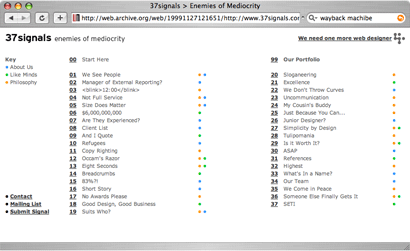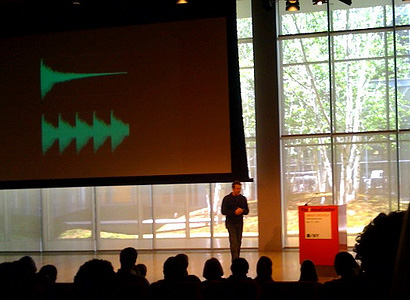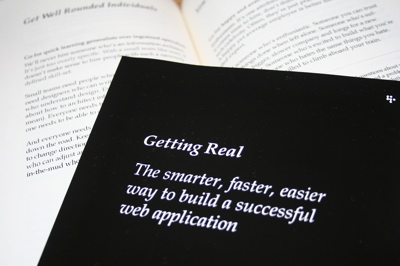I somewhat vividly remember the first time I saw the web site of 37Signals: I was at the lumbering internet consultancy of USWeb/CKS sitting anxiously in my “creative” (read, made of steel with gruyere cheese holes cut out of it) cubicle with nothing to do, when one of our web geeks sent everyone a link to their site. This was 1999. And their web site looked like nothing that had made it unto the internet so far: It was simple, evocative, and it had none of the default electric blue underline links that constituted the web standards of the day. For close to ten years, I have been a fan of 37Signals. But funnily enough, I don’t use any of their products, I don’t read their blog, and I didn’t purchase their book — I simply admire the way they move forward.

37 Signals, 1999. Bigger view on the Wayback Machine.
Presenting for 37Signals was Jason Fried, one of the original founders, and the only remaining one. Founded in Chicago in 1999 with Ernest Kim (left in 2003) and Carlos Segura (left in 2000), it started as a web design firm offering only web design services, no extra bells, whistles or services — if a client wanted everything, they could go elsewhere… like USWeb/CKS. Since the beginning 37Signals has been a profitable business, which would have lured anyone into growth, but they decided to stay small. By 2002, their projects were becoming more complex and complicated, and he noticed that the more money that clients were paying, the more they wanted to be involved. Not their idea of a good time.

Jason Fried on stage at Smart Models. Photo by Michael Surtees.
A very incisive observation that Jason made was that with big projects, the initial excitement of when the project starts invariably dwindles as it slows down and loses its momentum. The image above shows the only slide Jason used throughout his presentation; the top graphic represents this dilution of excitement. The bottom graphic represents the kind of projects, tasks and dynamic that 37Signals prefers to operate on: Quick and energetic projects that “amplify that initial sense of excitement.”
One approach that met this criteria was a period of time when they offered 37Express, a service where clients would pay $3,500 and 37Signals would design one page (yes, just one page) in a week. If the client didn’t like it, they had to pay another $3,500 for another design— “simple expectations, low risk,” as Jason put it. Then came a point where they were doing quite a bit of these projects and were very busy, and client communications started to break down, with dispersed information everywhere. They looked for a project management tool that could help them manage this aspect of their business, where they could store files for download, benchmark dates, conversations, etc. When they couldn’t find one, they built their own. And that’s how Basecamp was born.

The 37Signals product offerings.
37Signals put Basecamp on the market thinking that it would sell enough licenses within a year to become a successful product — within six weeks they had met their goals. That’s when 37Signals went from being a web design firm servicing clients, to a web application developer servicing customers. “The happiest day of my life,” quipped Jason. Basecamp was born out of their own needs, and that’s something that Jason emphasized consistently, “scratch your own itch,” and don’t wait for the market to tell you what to do. If you have an idea that meets a need you have, it’s likely that someone else will have it. A comparison that Jason later made in the panel discussion is that usually your best work is the work you do for yourself: Just look at the house of an architect, it’s usually their best design.

Getting Real: The smarter, faster, easier way to build a successful web application.
One of the traits that exemplify 37Signals and their work is simplicity, getting rid of all extraneous features and focus on doing a few things very well. Jason made one interesting comparison of their products against those from large software developers: 37Signals is building products that they will sell to the end-user, so if I, Armin Vit, buy Basecamp I will be the one using it; as opposed to big software that sells in bulk to a company with thousands of employees, relying on thousands of features to outsell the competition. Like this, there are dozens more nuggets of wisdom in 37Signals’ book Getting Real, which you can read for free online, or you can pay $19 and own as a PDF — and somehow more than 30,000 copies have been sold; that’s more than half a million dollars for a book that requires no distribution or printing costs.
Even as web application company, there is a lot to learn and a lot that applies to running a design firm, and Jason never ran short of interesting points of view. When asked what he thought of project managers, after saying that he hated them, he made the point that if you need a project manager it means the project is too big to handle for the person doing the work. Project managers have always been a thorny issue with graphic design firms… having worked in both environments, one where designers have little to no interaction with the clients, and the other where the designer is the only point of contact with the client, I wholeheartedly agree with Jason. Communication is more efficient, targeted and constructive when it’s direct with the client.
He also talked about growth, that he isn’t keen on outlandish growing. If a project is too big, instead of hiring more people to meet the needs of that project it might be wiser to scale back the scope of that project.
Another interesting aspect of 37Signals is transparency. As I mentioned in the beginning, I have consistently followed their work and progress, and the only way that is possible is because they are very public about what they do. They write about it in their blog and they are not tight-lipped about their process. He drew a parallel to chefs: They write cookbooks, they reveal their formulas. And also mentioned that you can “out-spend” your competition, or you can “out-teach,” and they certainly excel at the latter.
Finally Jason talked about the environment of their office. To instill jealousy in everyone, they don’t work Fridays. For them — they are currently ten people, five in Chicago and five across the U.S. — it’s always a four-day week, which forces them to focus on getting all their work done in that time, instead of putzing around for 40 hours spread in 5 days. They don’t have meetings, which they hate — for Jason, a 1-hour meeting with 10 people is not a 1-hour meeting, it’s a 10-hour meeting — and instead they communicate through Basecamp or Campfire. Another cool thing they do for their employees is that they will finance their hobbies. So if someone wants to take piano lessons, they will pay for it, as long as they share what they have learned in return — which doesn’t mean they have to teach everyone how to play the piano, but there might be some principles or practices that can be applicable to what they do.
Overall, Jason’s presentation was great. To some, I think his ideals may be too far fetched, hardcore or unattainable in a typical environment, but 37Signals walks the walk and, luckily for all of us, they talk the talk too.






Definitely agree. It doesn't necessarily work for everyone, but their philosophy and perspectives worked for them in spades.
If anything, they provide a certain level of inspiration and advice that you can analyze and choose to make it work for you. The industry needs more companies like that.
On May.27.2008 at 05:50 PM